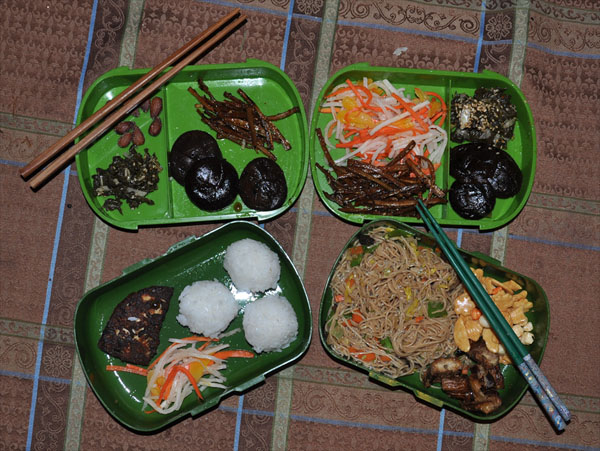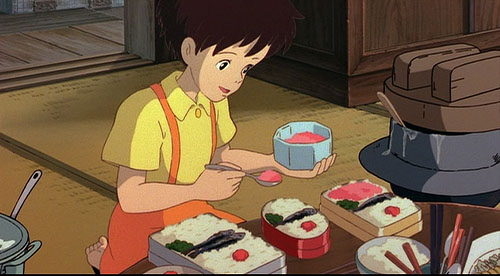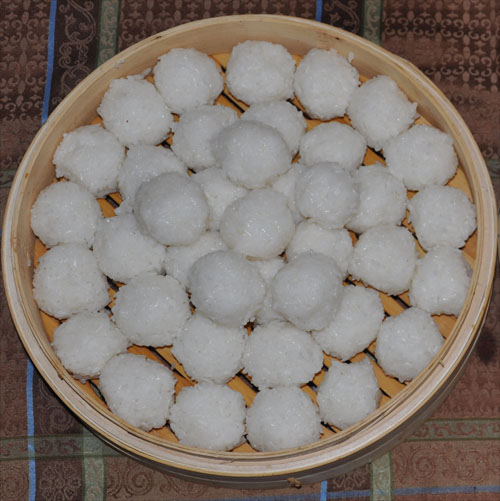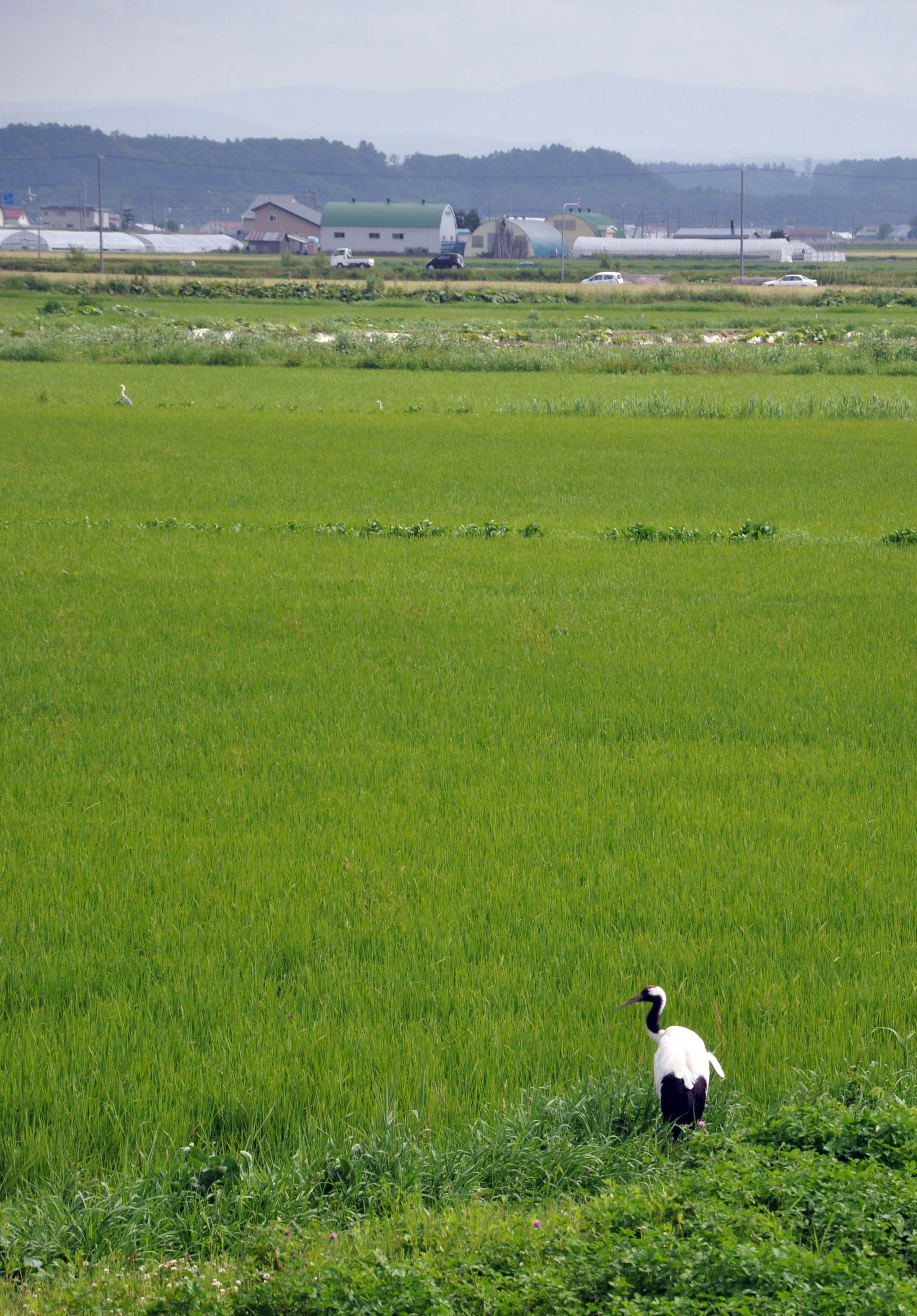
Bentō and Onigiri
Bentō (弁当) is the lunch and takeaway meal of Japan. Traditionally a bentō will contain rice, fish or meat, and pickled or cooked vegetables, representing an attractive diversity of cooking methods, textures, colors, and flavors, usually carried in a box-shaped container which ranges from disposable plastic to hand crafted lacquer ware. Bentō can be traced back to the 1200s when it consisted primarily of parboiled rice. By the late 1500s light meals began to be served in wooden lacquered boxes. It was during the Edo Period from 1603-1868 that bentō spread and became refined. Travelers began making a lunch of rice balls or onigiri (おにぎり) wrapped with bamboo leaves or carried in a bamboo box.
For this month we have created a vegetarian bentō made of rice balls and a variety of savory, spicy or pickled vegetables. Consider taking your bentō out into the spring countryside and have a picnic with it in a place that captures the transient beauty of the first green grass, breaking tree buds, and spring flowers.
Rice was brought to Japan around 4000 years ago from the Asian mainland (below is a rice field at Abashiri in eastern Hokkaido with a Red-crowned Crane). Although other grains are also used in the Japanese diet (in particular wheat and barley), rice became the staple which fed the culture, with the word for plain boiled rice, gohan (御飯), becoming synonymous with the word for ‘meal’ itself. Vinegared Rice (酢飯 or Sumeshi)3 cups Japanese (or sushi) rice such as Kokuho Rose Place rice in a deep bowl and fill with cool water. Mix until the water becomes white and chalky. Drain water and repeat this rinsing until the water runs fairly clear. Drain rice in a strainer and tap to remove excess liquid. In a 5 quart saucepan combine rinsed and drained rice, kombu, and water. Soak for 15 minutes. Mix together vinegar, sugar, sake, mirin, and salt until all the ingredients have dissolved. Bring rice and water to a rolling boil and reduce heat to low. Cover and simmer for 15 minutes. Remove from heat and let stand, covered, for another 15 minutes. With a damp wooden spatula or spoon remove rice to a wooden basin or a ceramic or glass bowl. Sprinkle the vinegar dressing over the rice. Place in front of a running fan, and toss the rice until the dressing has been completely absorbed and the rice has cooled to almost room temperature. There are a few specialized ingredients in this recipe, including kombu (dried kelp), sake (rice wine), mirin (a sweet cooking sake), and rice vinegar. These can all generally be found at any Japanese market. With so few ingredients, your onigiri will only be as good as your rice, sake, mirin, and rice vinegar. Don't skimp on these. In particular don't use the commonly available non-alcoholic 'mirin' made from corn syrup (take a look at the ingredient list to make sure). These taste artificial and are not worth the bother. We are very happy with the sake and mirin made in Vernon, California by the Yaegaki Brewery, and highly recommend that you search out their products. We also recommend heirloom Kokuho Rose rice, a strain bred by Keisaburo Koda in the San Joaquin Valley of California. |


 We begin with onigiri. Although traditionally simple balls of plain boiled rice, we especially like the flavor of sushi rice. So, we’ll make our rice balls from vinegared rice or sumeshi (酢飯; see picture to right).
We begin with onigiri. Although traditionally simple balls of plain boiled rice, we especially like the flavor of sushi rice. So, we’ll make our rice balls from vinegared rice or sumeshi (酢飯; see picture to right).  Japanese rice varieties are noted for their high levels of amylopectin, a soluble polysaccharide and highly branched polymer of glucose, and one of the two components of starch. As a result, this rice is sticky when cooked, which makes it easier to eat with chopsticks as this allows the rice to be picked up in clumps rather than as individual grains. The process of cooking Japanese rice is one of removing enough -- but not too much -- of the amylopectin to allow for pleasantly sticky but not impossibly congealed grains. This is accomplished by first rinsing the rice a number of times in water, pre-soaking, and then finally cooking in as little water as possible. Do not try this recipe using other rice varieties -- in particular long-grain Basmati or other non-sticky varieties as the rice balls will simply not hold together! This is not your mother’s or grandmother’s rice recipe, in which
Japanese rice varieties are noted for their high levels of amylopectin, a soluble polysaccharide and highly branched polymer of glucose, and one of the two components of starch. As a result, this rice is sticky when cooked, which makes it easier to eat with chopsticks as this allows the rice to be picked up in clumps rather than as individual grains. The process of cooking Japanese rice is one of removing enough -- but not too much -- of the amylopectin to allow for pleasantly sticky but not impossibly congealed grains. This is accomplished by first rinsing the rice a number of times in water, pre-soaking, and then finally cooking in as little water as possible. Do not try this recipe using other rice varieties -- in particular long-grain Basmati or other non-sticky varieties as the rice balls will simply not hold together! This is not your mother’s or grandmother’s rice recipe, in which